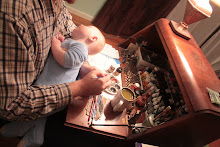To have a good miniatures game, you need rules, miniatures, a surface to play on, terrain, and various accouterments (dice/cards/counters/markers etc.).
For World War II skirmish games I had the first three, but was lacking the third. Since I knew that the forces I was collecting were roughly centered on "late war" and more specifically Normandy (with the paratroopers in the earlier uniforms), I thought that Northern France would be a good place to start.
Now, as you know, Normandy is about as well trod a war-gaming ground as you can find. D-day, and the months following have built up about as much mythology as you can for something so recent, and of course the terrain itself lends itself to smaller actions, which are easier to war-game on the tabletop convincingly. (even if large actions lend themselves to greater historical accuracy...)
So Normandy terrain.
Fortunately as mentioned above this is a well hoed row, and there are plenty of inspiring builds out there. In addition, there are plenty of commercially made items for sale, and a plenty of photo-graphical evidence as well, since both the Commonwealth and US armies were accompanied by photographers and other journalists.
A rational person, or at least one not so cheap as I am, would view the above, and then go to some MDF laser cut shop and buy a small village, customize that a bit, and move on. Not being rational, and being cheap, I went another route:
Unfortunately I did not take any pictures of the first couple buildings at the early stages of construction, but here you can see on in progress to give you an idea of how these went. Card stock carcass, card and paper details, and modeling putty "skin". Other buildings got a skim coat of drywall jointing compound, and a couple got foam sheet stone work.
After a "few" hours we end up here:
Then it came time to do shingles...
I cut a bunch of these out on the Silhouette Cameo we have (as well as the windows, shutters and other details), but they covered only one half of one roof, and then I laboriously cut out most of the rest of the strips by hand. As you might expect, making the same motion over and over again hundreds of times is not great for the ol'muscular-skeletal system, and with eight buildings to cover it took a long time.
 |
| Scale check |
 |
| The nice thing about old buildings is that they can be used in many eras... |
Throughout this project I collected pictures on the internet and printed some of them out, made sketches, doodled in the margins of other things, and otherwise compared terrain to the actual thing. Google street view came in handy as I "drove" around Normandy looking at old villages and farm roads. I even had my sister send me some vacation pictures she had taken from one of her trips to Normandy (brother-in-law is
a Band of Brothers fanatic).
Lots more to come on these buildings!
To be continued:




































